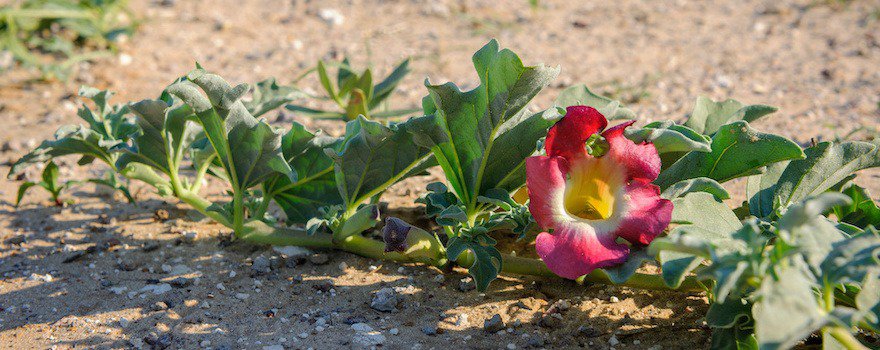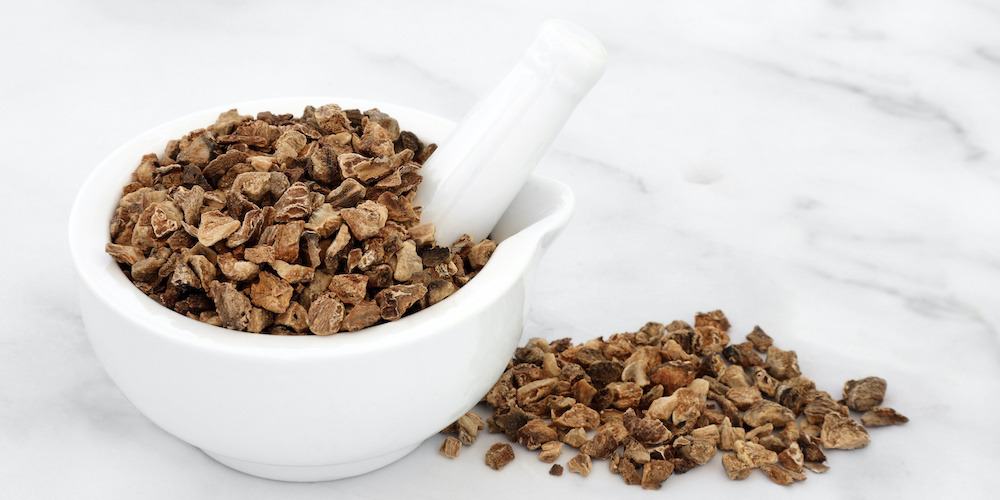BENEFITS OF HARPAGOPHYTUM
✓ Reduces inflammation
✓ Relieves joint pain
✓ Antioxidant
✓ Stimulates appetite
What is harpagophytum?
Harpagophytum (Harpagophytum procumbens) is a plant native to South Africa. It is found in semi-desert regions and in the Kalahari Desert.
It produces a central root and then bulbous secondary roots (tubers) that allow it to store water. Thus, it can withstand long periods of drought.
The plant is nicknamed “devil’s claw” in reference to its spiny, hooked fruits. Thanks to these spines, the fruit can cling to the fur of animals to be transported and thus disseminated in nature.
As shown in this review, harpagophytum holds an important place in African traditional medicine. It is indicated for relieving indigestions, fever, or rheumatism as this review reports.
The tubers are used because they contain the main active compounds, including harpagosides. Once harvested, they are dried and cut into slices before being consumed.
Today, the plant is used in modern phytotherapy. Research has highlighted its anti-inflammatory action, which helps relieve joint pain. It is also antioxidant and capable of stimulating appetite.
Nutritional Composition
- Amino Acids
- Vitamins: provitamin A, C, B1, B2, B3, B5, B9, B12
- Minerals and Trace Elements: iron, potassium, copper, magnesium, silica, phosphorus, calcium
- Antioxidant Actives: flavonoids, phenols
- Organic Acids: cinnamic acid, chlorogenic acid
- Harpagosides

The Benefits of Harpagophytum
🔥 Reduces inflammation
The tubers contain natural compounds called “iridoid glycosides” that help regulate inflammation. Among them, harpagosides are the most important.
They directly target inflammation and the molecules involved within the body. Thus, they prevent the release of TNF-α (tumor necrosis factor-alpha), a pro-inflammatory cytokine.
In addition, they inhibit the activity of interleukins IL-6, which can cause excessive inflammatory responses.
Thus, harpagophytum is useful in cases of acute or chronic inflammation of the osteoarticular and musculoskeletal spheres: arthritis, osteoarthritis, tendinitis…
This study from the University of Caen Normandy (France), conducted on human cells, shows its beneficial effects on inflammation in cases of osteoarthritis.
🏃🏻♂️ Relieves joint pain
Harpagosides have analgesic action, meaning they alleviate or even suppress pain. Thus, in addition to reducing inflammation, they relieve the pain it induces.
They help alleviate rheumatism and joint pain associated with arthritis or osteoarthritis. They also act on mobility and stiffness to regain joint comfort.
Finally, the plant is recommended for back pain, lumbago, lower back pain, sciatica, or stiff neck.
This study from Queen Margaret University in Edinburgh (Scotland), conducted on patients with rheumatic disorders, demonstrates its effectiveness in relieving arthritis.
🥝 Antioxidant
The roots of harpagophytum contain antioxidant compounds. They notably include flavonoids, phenols, and a small amount of vitamin C.
All these compounds fight against free radicals which damage cells, promote cardiovascular diseases, and cancer development.
This study from the National University of Science and Technology of Zimbabwe, conducted in the laboratory, demonstrates the plant’s antioxidant activity.
🍽 Stimulates appetite
Like dandelion or fenugreek, harpagophytum stimulates appetite. It is suitable in cases of loss of appetite or asthenia (general fatigue accompanied by loss of appetite and weight loss).
It contains bitter compounds that stimulate the taste buds, promote the secretion of gastric juices, and support biliary functions.
Moreover, by prompting the stomach to produce gastric juices, it aids digestion and alleviates dyspepsia (bloating, abdominal pain, flatulence, etc.).
Further studies are needed to understand its action on appetite.

How to consume it?
In capsules or tablets
The capsules and tablets are made from root powder. This format is convenient, easy to take, and has the advantage of being tasteless.
Indeed, pure harpagophytum powder is bitter. Its taste does not necessarily appeal to everyone.
For greater effectiveness, the capsules should be sufficiently dosed in harpagosides, the plant’s main active compounds.
Choose a supplement offering a high concentration of at least 30% harpagosides.
In powder form
The powder mixes easily with water, fruit juice, plant milk, or a health drink.
But it has a relatively pronounced and bitter taste.
Furthermore, it does not provide the best concentration of harpagosides.
In liquid solution
Harpagophytum can be found in liquid preparations, in the form of mother tincture or drinkable ampoules.
These formats are rich in active ingredients and are suitable for a multi-day course.
Note: the mother tincture contains alcohol. It is not recommended for pregnant women, children, or individuals with certain medical conditions.

In dried roots
The dried roots are prepared as tea or in decoction.
Simply soak them in boiling water for 5 to 10 minutes.
You can soften the drink’s bitterness by adding honey or lucuma powder.
Opt for organic harpagophytum
If possible, opt for harpagophytum grown organically. This ensures a product free from pesticide residues and an environmentally friendly cultivation.
There are also fair trade supply chains that support the work of small producers in Namibia, the main producer of harpagophytum.
Dosage
The average recommended dosage is 600 to 1200 mg per day.
Contraindications and side effects
Its consumption has certain contraindications:
- As a precaution, harpagophytum is not recommended for pregnant and breastfeeding women and young children;
- Individuals suffering from gallstones or ulcers should avoid consuming it;
- Harpagophytum may interact with certain medications. Consult your doctor if you are undergoing treatment.
Its consumption has certain side effects:
- Digestive disorders
- Nausea
- Diarrhea
- Headaches
- Dizziness
If you experience side effects, discontinue use and consult a doctor.
Sources and scientific studies
Sibonokuhle F Ncube, Lyndy J McGaw, Emmanuel Mfotie Njoya, Hilton G T Ndagurwa, Peter J Mundy, Samson Sibanda, 2021. The benefit of combining curcumin, bromelain and harpagophytum to reduce inflammation in osteoarthritic synovial cells.
Mary Warnock, Douglas McBean, Andreas Suter, Jen Tan, Patricia Whittaker, 2007. Effectiveness and safety of Devil’s Claw tablets in patients with general rheumatic disorders.
Thomas Brendler, 2021. From Bush Medicine to Modern Phytopharmaceutical: A Bibliographic Review of Devil’s Claw (Harpagophytum spp.).
Luigi Menghini, Lucia Recinella, Sheila Leone, Annalisa Chiavaroli, Carla Cicala, Luigi Brunetti, Sanda Vladimir-Knežević, Giustino Orlando, Claudio Ferrante, 2017. Devil’s claw (Harpagophytum procumbens) and chronic inflammatory diseases: A concise overview on preclinical and clinical data.



